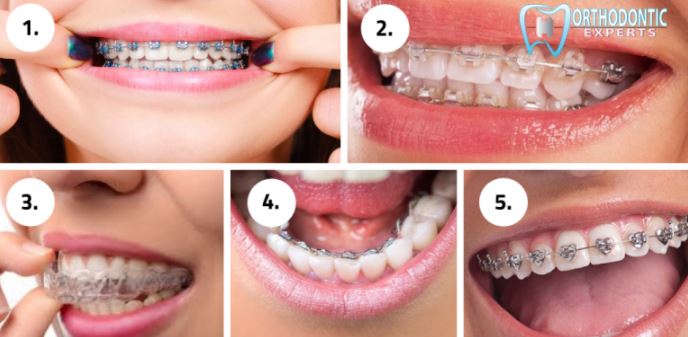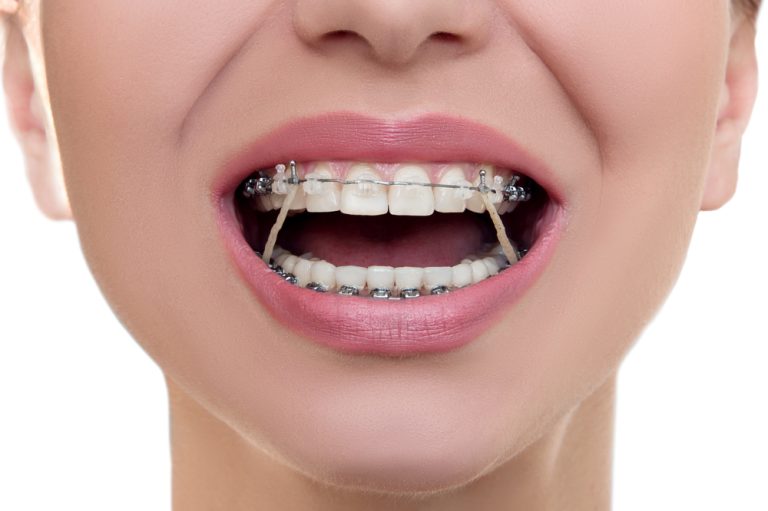Last Updated on 3 weeks by DR. ALBIN SIPES
In dentistry, there are many different types of braces. The most common type is metal braces, which are made of stainless steel or titanium. These braces are strong and durable, but they can also be quite noticeable.
Ceramic braces are less visible because it’s tooth color. However, they may not be as strong as metal braces and may require more frequent adjustments. Invisalign® is a popular alternative to traditional braces that uses clear, removable aligners instead of brackets and wires.
This treatment is virtually invisible and can be removed for eating, brushing, and flossing.
If you’re considering braces, you may be wondering what your options are. Here’s a rundown of the different types of braces available:
Metal Braces: Metal braces are common and it’s made of high-strength stainless steel which is very durable. They’re also the most visible type of braces, so if you’re looking to keep your treatment on the down low, metal braces aren’t for you.Ceramic Braces: Ceramic braces are less visible than metal braces but more visible than lingual braces (see below). Ceramic brackets can also be stained by certain foods and drinks, so they require a bit more care than metal brackets. Lingual Braces: Lingual braces are similar to metal braces, except they’re placed on the inside surfaces of your teeth (hence the name “lingual” meaning tongue-side).
This makes them completely invisible from the outside, making them a popular choice for adults who don’t want their treatment to be noticeable. However, lingual treatment can be more uncomfortable than traditional metal or ceramic treatment since your tongue will come into contact with the brackets and wires. Invisalign: Invisalign is a popular alternative to traditional braces that uses clear plastic aligners instead of brackets and wires.
The aligners are virtually invisible when worn and can be removed for eating, drinking, brushing, and flossing—making them much more comfortable and convenient than traditional braces. However, Invisalign isn’t suitable for everyone—it generally works best for mild to moderate cases of misalignment. So there you have it!
These are just a few of the different types of brace options available—talk to your orthodontist about which one is right for you!

Credit: www.orthodonticexprts.com
Which Type of Braces is the Best?
There are a few different types of braces that people can choose from, and the best type of braces for each person will vary depending on their individual needs. The most common types of braces are metal braces, ceramic braces, and invisible aligners.
They are made of stainless steel or titanium alloy, and they use brackets and wires to move teeth into place. Metal braces are very strong and durable, and they can be used to treat a wide variety of dental issues. However, because they are so visible, many people prefer other types of braces.
Ceramic braces are made of clear or tooth-colored materials, so they blend in with your teeth and are much less noticeable than metal braces. They work in the same way as metal braces, using brackets and wires to move teeth into place. Ceramic braces tend to be more expensive than metal ones, but many people feel that they are worth the extra cost because they are less noticeable.
Invisible aligners (also called “clear brackets”) are a newer type of orthodontic treatment that uses clear plastic trays instead of metal brackets and wires. Invisible aligners gradually move teeth into alignment over time, and since they’re clear, they’re virtually invisible when you wear them. Many people prefer invisible aligners because they’re more aesthetically pleasing than traditional metal or ceramic braces.
Which Braces Work the Fastest?
There are many types of braces that work relatively quickly to straighten teeth. However, the amount of time that it takes for braces to work can vary depending on the type of braces and the severity of the misalignment. For instance, traditional metal braces typically take longer to work than clear ceramic braces.
Additionally, if a person has a more severe misalignment, it may take longer for their braces to correct the issue. In general, though, most people can expect their braces to begin working within a few months.
Which Type of Braces is the Cheapest?
There are many types of braces that vary in price. Some of the cheapest braces include metal braces, which typically cost between $3,000 and $5,000. Other cheap options include ceramic braces, which typically cost between $4,000 and $8,000, and clear plastic aligners, which typically cost between $2,500 and $5,000.
The most expensive type of braces is invisible braces, which can cost up to $10,000. However, there are many financing options available to help make these costs more affordable.
Types Of Orthodontic Treatment | Which Braces Are Right For You?
Self-Ligating Braces?
If you’re looking for a more efficient and faster way to achieve straighter teeth, self-ligating braces may be the right option for you. Unlike traditional braces that require elastics or metal ties to hold the wire in place, self-ligating braces use a slide mechanism that gently moves your teeth into alignment. Not only do self-ligating braces require fewer adjustments than traditional braces, but they can also reduce treatment time by up to 50%.
Self-ligating brackets are made of the same materials as traditional metal braces – medical-grade stainless steel or titanium. The brackets are bonded to the front surfaces of your teeth using a dental adhesive and connected with an archwire. Instead of using elastics or metal ties, the archwire is held in place by a small door that opens and closes to allow the wire to slide back and forth.
One of the biggest benefits of self-ligating braces is that they’re more comfortable than traditional metal braces. Because there’s no need for elastic ties or other hardware, you won’t experience any irritation or discomfort when wearing self-ligating braces. Additionally, self-ligating braces put less pressure on your teeth and gums, which can lead to faster treatment times.
If you’re interested in straightening your teeth with self-ligating braces, contact your orthodontist today!
Lingual Braces?
Lingual braces are a type of braces that are placed on the tongue side of the teeth. This makes them virtually invisible when you smile, talk, or laugh. Lingual braces are custom-made and require a high level of skill to fabricate and fit.
They are more expensive than traditional braces, but many people feel they are worth the extra cost because of their cosmetic appeal.
Types of Braces And Cost?
If you are considering braces for yourself or your child, it is important to know that there are different types of braces and that the cost can vary significantly. Here is a breakdown of the different types of braces and their approximate costs: -Metal braces: These are the most traditional type of braces and are made from high-grade stainless steel.
They are strong and durable but can be more visible than other types of braces. Metal braces typically cost between $3,000 and $5,000. -Ceramic braces: These braces are made from clear or white ceramic material and are less visible than metal braces.
Ceramic braces typically cost between $4,000 and $6,000. -Lingual (“invisible”) braces: Lingual brackets are attached to the back side of teeth so they are not visible when smiling or talking. Because they require custom fabrication, lingual brace treatments can be more expensive than other types, typically costing between $8,000 and $10,000.
Types of Metal Braces?
There are many types of metal braces that an orthodontist may use to correct your smile. The type of braces that will be best for you will depend on the severity of your misalignment, the size and shape of your teeth, and your personal preference. Traditional Metal Braces: Traditional metal braces are the most visible type of braces.
They are made of high-grade stainless steel or titanium alloy wires and brackets that are glued or cemented to the front surfaces of your teeth. Although they are noticeable, today’s metal braces are smaller, sleeker, and more comfortable than ever before. Clear Ceramic Braces: Clear ceramic braces offer the same great results as traditional metal braces but with far less visibility.
The brackets on clear ceramic braces are made of a translucent material that blends in with your teeth so they’re much less noticeable than metal ones. The wire that runs through the brackets is also usually clear or tooth-colored, further reducing their visibility. Lingual Braces: Lingual braces offer all the benefits of traditional metal braces but with one major difference – they’re placed on the back surfaces of your teeth so they’re completely invisible when you smile!
Because they’re custom-made to fit snugly against the backs of your teeth, lingual braces can be more uncomfortable than other types at first (but this typically goes away after a few weeks). They also require very careful cleaning to avoid plaque buildup around the brackets and wires.
Conclusion
There are many different types of braces that can be used to straighten teeth, and each type has its own advantages and disadvantages. The most common type of braces is metal braces, which are made of brackets that are glued to the teeth and connected by wires. Metal braces are the least expensive type of braces, but they can be very visible and may cause irritation to the gums.
Ceramic braces are made of clear or white brackets that blend in with the teeth and are less visible than metal braces. They are more expensive than metal braces, but they may be a good option for people who want to avoid the appearance of metal braces. Invisalign is a newer type of brace that uses clear aligners instead of brackets and wires.
Invisalign is more expensive than other types of braces, but it is also much less visible. There are also some drawbacks to Invisalign, such as the fact that it can be difficult to keep them clean.


